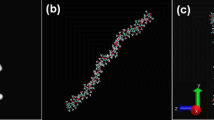Abstract
Computer simulation studies using the method of molecular dynamics have been carried out to investigate osmosis and reverse osmosis in solutions separated by semi-permeable membranes. The method has been used to study the dynamic approach to equilibrium in such systems from their initial nonequilibrium state. In addition density profiles of both the solute and solvent molecules have been investigated, especially near the walls for adsorption effects. Finally the diffusion coefficients and osmotic pressure have also been measured.
Our results show both osmosis and reverse osmosis, as well as a smooth transition between the two when either the solution concentration is changed, or the density (pressure) difference between the solvent and solution compartments is varied. We believe this new method can be used to improve our understanding of these two important phenomena at the molecular level.
Similar content being viewed by others
References
Banavar, J.R., J. Koplik, and J.F. Willemson, Computer Simulation Studies in Condensed Matter Physics III, Vol. 53, Springer Proceedings in Physics, Springer-Verlag, Berlin, 1990.
Bojan, M.J., A.V. Vemov, and W.A. Steele, “Simulation Studies of Adsorption in Rough Walled Cylindrical Pores,” Langmuir, 8, 901 (1992).
van't Hoff, J.H., “Die Rolle des Osmotischen Drucken in der Analogie Zwischen Losungen und Gasen,” Z. Phys. Chem., 1, 481 (1887).
Hoomaert, P., Reverse Osmosis, Pergamon, Oxford, 1984.
Mo, G. and F. Rosenberger, “Molecular Dynamics Simulation of Flow in a Two Dimensional Channel with Atomically Rough Walls,” Phys. Rev. A., 42, 4688 (1990).
Murad, S., P. Ravi, and J.G. Powles, “A Computer Simulation Study of Fluids in Slit, Tubular, and Cubic Micropores,” J. Chem. Phys., 98, 9771 (1993).
Murad, S., P. Ravi, and J.G. Powles, “Anisotropic Thermal Conductivity of a Fluid in a System of Microscopic Slit Pores,” Phys. Rev. E., 48, 4110 (1993a).
Panagiotopoulos, A.Z., N. Quirke, M. Stapleton, and D.J. Tildesley, “Phase Equilibria by Simulation in the Gibbs Ensemble-Alternative Derivation, Generalization, and Application to Mixtures and Membrane Equilibria,” Mol. Phys., 63, 527 (1988).
Sourirajan, S., Reverse Osmosis, Academic, New York, 1970.
Taylor, H.S., A Treatise on Physical Chemistry, Van Nostrand, New York, 1925.
Weissberger, A. (Ed.), Physical Methods of Organic Chemistry, Part 1, Chapter 6, Interscience, New York, 1960.
Author information
Authors and Affiliations
Rights and permissions
About this article
Cite this article
Murad, S. Molecular dynamics simulations of osmosis and reverse osmosis in solutions. Adsorption 2, 95–101 (1996). https://doi.org/10.1007/BF00127103
Issue Date:
DOI: https://doi.org/10.1007/BF00127103




